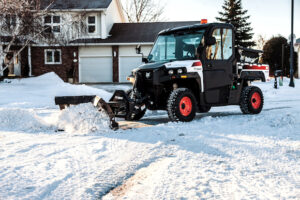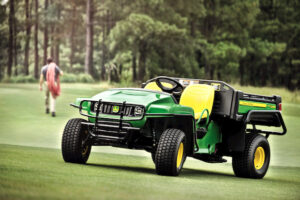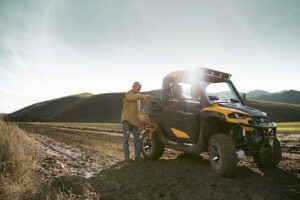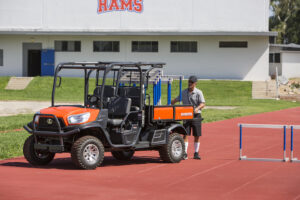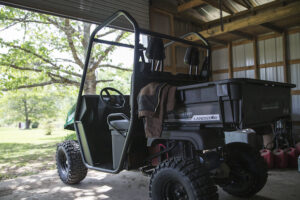UTV Trends
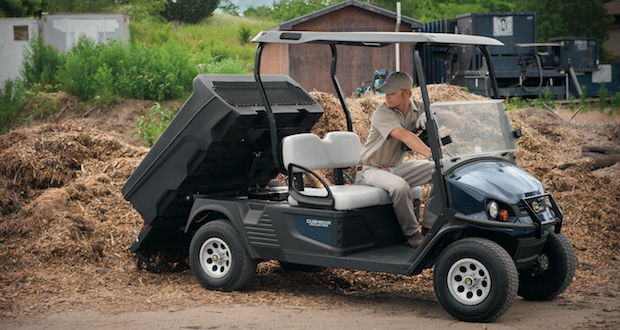
Landscape and Irrigation recently asked leading utility task vehicle (UTV) experts about the latest UTV trends, and the growing range of uses for UTVs in the landscape and irrigation industries.
L&I: Tell us about your latest UTV offerings, especially anything geared toward landscape industry professionals or professional grounds managers.
In the Fall of 2016, American LandMaster was proud to unveil their completely new, re-engineered line of UTVs called LandStar. With an in-depth understanding of UTV customers and what they want in and from their UTVs, American LandMaster created an exciting and forward-thinking design and feature rich line of UTVs. By leveraging over 50 years of American-made experience in off-road design and development, American LandMaster has created a proven UTV that professionals can rely on. Ranging in power from the 2-wheel-drive LS350 to the fully capable, fully powered LS670, the vehicles are built tough to handle the challenges of professional landscape contractors.
— Eric Hall, marketing director, American LandMaster
Bobcat Company introduced four new Model Year 17 vehicles — the 3400, 3400XL, 3600 and 3650 — to better serve landscape industry professionals and grounds managers. The newest machines are designed to deliver maximum power and performance for increased productivity and operator comfort.
All four utility vehicles provide ample horsepower and speed, allowing for increased jobsite productivity. The 3400 and 3400XL models are available with two engine configurations: a 40-horsepower gas engine or a 24-horsepower diesel engine. The gas and diesel engines provide operators with exceptional performance <dash> up to 40 mph with a dealer-installed kit. The 3600 and 3650 utility vehicles have a 24-horsepower diesel engine, and come standard with hydrostatic drive.
An adjustable de Dion rear suspension helps distribute trailer weight across the back tires, instead of weighing down the chassis, improves the vehicle’s ride comfort, and provides more stability to haul and tow heavy loads.
Improved operator and passenger comfort is another quality feature of Bobcat utility vehicles. The MY17 models include a raised bar that covers the arm and shoulder — and allows for easier entry and exit. An updated Roll Over Protection Structure (ROPS) cross brace was added to reduce noise in addition to full rollover protection to protect operators and passengers.
Bobcat also added a larger 8-ply radial constructed mud tire for better off-road performance and increased ground clearance on the 3400 and 3400XL utility vehicles. The 26-inch-tall mud tire has a tread, making it ideal for landscape professionals and grounds maintenance managers working in mud and dirt. When working on turf, a turf tire option is available, which provides superior floatation to reduce the impact on a jobsite.
Specific to the 3650 is the Multi-Attachment X-Change (M.A.X.) system and standard auxiliary hydraulics, providing integration and versatility not found on ordinary utility vehicles. The 3650 has the capability of powering front-mounted PTO-driven attachments, including an angle broom, mower and snowblower. Non-PTO attachments <dash> bucket, grapple, pallet fork and snow blade, and snow V-blade <dash> can also be powered by the 3650.
— Chris Austinson, utility vehicle product specialist, Bobcat Company
The new Challenger Series 550 and 750 utility vehicles were built to get the job done with 500-pound bed capacity, 1,200-pound towing capacity, and a 3,500-pound standard winch. Standard front and rear hitch receivers offer flexibility for towing and maneuvering trailers or mounting accessories. Three-way adjustable shocks, 12-inch ground clearance, and off-road tires mean these vehicles can go wherever the work is.
While it’s not a new product for 2017, the Volunteer WT utility vehicle was designed to handle any task. It has an oversized pallet-capable dump bed with a 1,200-pound capacity, electric lift bed with hinged and removable sides.
— Tom Mielke, utility vehicle product manager, Cub Cadet
Cushman had one goal in mind when we recently launched the new truck-inspired line of Hauler utility vehicles — build a vehicle that helps to effortlessly cut your task list down to size. Cushman engineered a practical UTV with more payload, a larger bed, and affordable accessories to let you do more. The new Hauler series includes the Hauler 1200, Hauler 1200X, Hauler PRO and the Hauler PRO-X.
The new Hauler comes equipped with a sound-dampening 12-cubic-foot roto-molded polyethylene bed, and can be upgraded to a 15-cubic-foot aluminum bed for extra space. The standard poly bed includes integrated divider slots to allow for increased organization and customizable bed storage. The aluminum bed features an L-track bed system that also allows for bed customization, and can accommodate hooks and brackets for convenient tie-down locations and space-saving accessories.
These models, available with either a gas or 72V AC electric powertrain, can be customized to fit the task at hand with the addition of a lineup of affordable accessories.
— Raven Honsaker, director of product strategy and development for Textron Specialized Vehicles (Cushman)
John Deere offers a wide range of utility vehicles to meet the needs of professional landscape contractors. From the traditional work series line, including the HPX, TE, TH, TS and TX models, to the crossover offerings, John Deere has a model that can tackle any job.
The work series models are ideal for landscaping jobs, providing the reliability and productivity landscapers need to tackle each day. With speeds ranging up to 25 mph, the work series models provide landscapers with the cargo space needed to carry tools and materials. The Gator HPX 4×4 is the fastest work utility vehicle in the Gator lineup with a top speed of 25 mph, but it’s also the most terrain capable with true four-wheel drive and a dual-range CVT transmission.
For landscapers who want a little more horsepower, the crossover category provides a variety of options, including models that boast speeds over 45 mph. The four-wheel-drive, heavy-duty XUV825i is the most popular John Deere model on the market today, featuring a 16-cubic foot cargo box that can convert to a flatbed and has numerous attachment options and storage. For landscapers looking for the most bang for their buck, the 28-mph XUV560 provides a durable workhorse that will help them tackle tough jobs. The XUV560 is equipped with several features, including an ergonomic operator station, four-wheel independent suspension and four-wheel-drive, and provides operators an affordable solution for their fleets.
— Mark Davey, marketing manager, Gator utility vehicles, John Deere
Kubota’s latest utility vehicle introduction is the RTV-X1140, featuring the innovative K-Vertible cargo conversion system, which transforms the vehicle from two passengers and a large cargo bed to four passengers and a cargo bed. Featuring sophisticated technology, the RTV-X1140 offers an impressive array of comfort and performance features with tilt steering, simple inline shifting, lockable storage and a long-travel four-wheel independent suspension that enhances handling in most off-road conditions. The new five-point ROPS design increases RTV-X1140’s legendary workhorse characteristics, allowing for more cargo volume and side loading. RTV-X1140 also comes standard with hydraulic dump bed.
— Rajesh Joshi, Kubota product marketing director, turf
We have a wide variety of Ranger UTV models that offer features such as turf mode for driving on sensitive terrain such as grass, dumping cargo boxes, seats for one to five passengers and different power options including gas, diesel and electric.
— Donna Beadle Polaris spokesperson
L&I: What trends are you seeing in the market overall with regard to UTV design, manufacture and sales?
We continue to see the UTV market grow and innovate. We believe that the UTV is not yet completely developed and will continue to grow in the next few years. Consumers are finding new ways to do more, better with their UTVs. They are being used for work, for play, for life.
— Eric Hall, marketing director, American LandMaster
Since the Great Recession, there has been a gradual increase of utility vehicle sales in the United States. This growth is due, in part, to the evolution of the design, performance and attachment capabilities of utility vehicles.
Today, these machines aren’t being viewed just as a machine that can get operators from point A to point B, but as a true tool carrier to complete a variety of projects. This allows landscaping customers to be more productive with compact equipment, expanding their machine’s jobsite abilities.
— Chris Austinson, utility vehicle product specialist, Bobcat Company
Designing with the user in mind, we added high-sided doors to the new Challenger Series 500 and 750 to offer protection from the elements and eliminate the need for intrusive hip and shoulder restraints to make it easier to get in and out of the vehicle. We also added under-hood storage, interior and exterior door handles, and familiar automotive-style controls on the dash.
Improving standard features that come factory installed on our utility vehicles, the new Challenger Series 550 and 750 come standard with a sealed windshield, hard roof, high-sided doors, winch, LED headlights, alloy wheels and side-view mirrors included. Other attachments are sold separately for limitless possibilities, including snowplows, folding windshields, tool and spare tire mounts, light kits and rear windows.
— Tom Mielke, utility vehicle product manager, Cub Cadet
We are seeing continued trends toward environmentally friendly options — the PRO is all electric, so it’s eco-friendly and zero emissions. And it’s quiet, so there’s no disruption to those around you if you’re working around people or in a public area.
We also see that customers demand more out of the products they are buying. The 72V system in the PRO provides the range to work a full day and get the most productivity out of the vehicle.
Making work easier is also more important. You see new UTV designs around accessories, bed features, convenience features in the operator area like easy entry and exit from the vehicle, ample legroom, and increased visibility on all sides. When you’re in and out of a vehicle all day, comfort and ergonomics are important. Enhanced bed designs are also popular, which make it easier to carry tools, organize materials and dump heavy loads.
— Raven Honsaker, director of product strategy and development for Textron Specialized Vehicles (Cushman)
Overall, the utility vehicle market remains strong, with an abundance of manufacturers introducing models, as seen during GIE+EXPO last October. With so many manufacturers entering the utility vehicle category, it is important for customers to evaluate the manufacturer, selecting a brand that will stand behind the product. For example, with 25 years producing our Gator Utility Vehicles, John Deere provides customers with heavy-duty vehicles that can withstand the demands of their business, and boasts an expansive dealer network and a 12-month/1,000-hour warranty.
Additionally, we are seeing an increased demand for attachments, which allow professional landscapers to transform their machines for a variety jobs. Front blades are extremely popular, enabling operators to move materials, such as dirt, or remove snow during the winter months. John Deere offers the broadest range of attachments for any manufacturer, offering an attachment for any job professional landscapers may face.
— Mark Davey, marketing manager, Gator utility vehicles, John Deere
The most significant trend has been the shift to crossover utility vehicles — also referred to multi-purpose off highway vehicles. This has been happening over the last few years as the market has grown in terms of the number of applications these vehicles are used now. These vehicles are mainly used for transportation purposes and may not be as well suited for heavy-duty applications. The other trends are comfort and performance. Four-wheel independent suspensions are almost a must now. Since the applications for UTVs are so varied now, manufacturers must plan to launch variety of attachments and accessories needed for the different applications these vehicles will be used in. Technology integration has been a topic of discussion, but has not become mainstream yet due to costs involved and the benefits being limited to fleet management, which is not as measurable in case of UTV as it might be for other equipment used by landscapers.
— Rajesh Joshi, Kubota product marketing director, turf
UTVs are incredibly versatile, and you are seeing more and more vehicles being offered just for work-specific tasks. Also, UTVs are easier to maintain than cars/trucks, making them cost effective.
— Donna Beadle Polaris spokesperson
L&I: How are landscape industry professionals utilizing UTVs? And how has the UTV market changed to better fit the needs of landscape professionals?
We believe that the landscape industry is continuing to diversify in how they use their UTVs. We see a large number looking for lighter-duty UTVs, often with turf tires, to handle simple jobs. They are looking to step up from a small, electric, golf-cart-type of UTV without spending the money for a high-end, fast UTV. At American LandMaster, we market the LS350 to this market. We also see the industry utilizing a higher-end 4-wheel-drive vehicle for larger projects. Typically this is a 600cc or higher engine. The vehicles typically have 4 wheel drive with locking differentials to create all the power and traction needed. At American LandMaster, we market our LS550 and LS670 to this demographic.
— Eric Hall, marketing director, American LandMaster
Landscape professionals are utilizing utility vehicles to efficiently transport passengers, supplies and tools to and from the jobsite. These machines help them get to their work more quickly than ever before, and are economical to run and operate.
Generally, professionals are spending more time in their machines, so manufactures like Bobcat Company have added comfort features such as improved visibility, ergonomic controls, easier entry/exit and comfortable seating. Some utility vehicles can now be configured with factory-installed cab heat and air conditioning for added comfort.
Advancements in drivetrain technology have also led to many manufacturers producing more versatile utility vehicles with larger payload and towing capacities, as well as higher power and performance.
Utility vehicles are also flexible in terms of where they can go. For instance, Bobcat utility vehicles have three drive mode selection options — turf mode, two-wheel drive and four-wheel drive — to match varying ground conditions. In turf mode, each wheel spins independently, allowing for minimal ground disturbance on turf, pavement and other hard-packed surfaces. Two-wheel drive allows both rear wheels to receive equal torque and spin for added traction on gravel roads, soggy trails and soft pasture. Four-wheel drive allows the machine to easily navigate in shallow streams, travel in snow-covered paths and pull trailers.
— Chris Austinson, utility vehicle product specialist, Bobcat Company
Utility vehicles are truly the Swiss Army knives of any commercial fleet, covering duties ranging from hauling tools, materials and people, to plowing snow or maintaining properties with sprayer and spreader attachments. Our focus is to create vehicles that are as flexible as possible so they can be adapted to whatever job is at hand, while maximizing crew safety, comfort and ease of operation.
— Tom Mielke, utility vehicle product manager, Cub Cadet
Professional landscapers are discovering the advanced functionality that UTVs offer. As landscapers expand their business offerings, the need to efficiently mobilize equipment has increased. UTVs, such as the Cushman lineup, are moving away from the “one-size-fits-all” model and are allowing users to customize their vehicles to fit specific needs.
New UTVs come with extensive accessory options to help workers transport trimmers and edgers, leaf blowers, hoses and bags of fertilizer — all while towing a mower from point A to point B. Companies are increasing the capacity of cargo beds, and offering hydraulic power bed options to make hauling mulch or dirt easier and safer for the landscaper. And, unlike a truck, UTVs are more nimble and lighter weight, enabling operators to move heavy loads to a variety of places with less potential damage to the grounds that they work hard to maintain.
Landscapers are seeing greater ROI on UTV purchases due to increased productivity. The cost savings that UTVs deliver are also being seen from improved vehicle mileage. Manufacturers are rolling out efficient gas or electric models. Our Hauler PRO has an impressive 50-mile range and a quiet, powerful 72-volt AC drivetrain, resulting in stamina that few gas vehicles can match.
Cushman is seeing a growing demand for improved ride quality, passenger comfort and safety. Larger space in the operator area, for example, allows crews to enter and exit the vehicle more easily. So, not only is the functionality of the UTV increased, but the ride is safer and more enjoyable.
— Raven Honsaker, director of product strategy and development for Textron Specialized Vehicles (Cushman)
Utility vehicles are a popular option in the landscape market, allowing professional landscapers to use machines to tackle a variety of tasks throughout the day. From moving crews, tools and materials to using machines to perform jobs such as salt spreading, spraying fertilizer or snow removal using a front blade, utility vehicles provide landscape contractors with a productive and efficient tool.
We are seeing more and more landscapers diversifying their businesses, taking on new jobs to increase revenue throughout the year. The utility vehicle market has continued to shift to keep up with the changes and provide customers with the tools they need to complete jobs. From offering new features to improve occupant comfort or machine performance to introducing new attachments that offer additional capabilities to operators, we are constantly striving to keep up with the changing market.
— Mark Davey, marketing manager, Gator utility vehicles, John Deere
Landscapers often use UTVs for transportation on large job sites to carry their planting/installation materials and tools around and from the base to the various locations. In irrigation and lighting applications, UTVs are helpful in conducting checks on sprinkler heads and leakages or light fixture failures and damaged wiring, etc. The versatility of UTVs does lend them to be equipped with various attachments and accessories depending on the application. A horticulture situation may call for a spray rig to be mounted on a UTV versus a snow application may call for a snow plow or snow thrower or a broom in the front and a salt spreader in the bed. Construction sites may carry compressors or pressure washers in the back of the UTVs to the point of use. Property maintenance professionals often use UTVs to transport mulch to the plants and shrubs around large properties. UTVs are fun to ride and drive and easy to get in and out of so some of the jobs that were done with pickup’s have been replaced by UTVs. UTVs are much more maneuverable and don’t cause as much turf damage, and are often cheaper in capital and operating cost than pickup trucks. They are more versatile in terms of people transportation, as well in case of situations where smaller groups of people need to be moved from one location to another within a job site. UTV uses are endless, and as more and more landscapers invest in them, they are finding more ways to get their jobs done efficiently and effectively.
— Rajesh Joshi, Kubota product marketing director, turf
They are being used to haul heavy loads such as rocks and mulch, hold tools, and even to grade plots. You are seeing more landscape-specific accessories and implements being made for landscape professionals.
— Donna Beadle Polaris spokesperson
L&I: For those landscape industry professionals who don’t own a UTV, what factors should they take into consideration to determine if adding a UTV is right for their company’s business model?
They should look at uses first. How will they be using this UTV. The type of tasks that they need to perform should drive the type of vehicle they decide to purchase. A clear understanding of the why they need a UTV will help the landscape professional make sure that the UTV matches the job.
— Eric Hall, marketing director, American LandMaster
There are a variety of utility vehicle options out there, so landscape industry professionals who are looking to own should first define what their needs are. It’s important they ask themselves how they will use the unit and whether the desired unit will meet their needs day in and day out.
Also, they should consider fuel type, passenger capacity, hauling and dump bed capacities and the climate in which the vehicle will be operated. Landscape professionals may need to have fully enclosed cabs, heat and air conditioning and power steering. In addition, they should consider any safety equipment that might be required on the jobsite such as dome lights, rear hard doors or rear window guards.
Landscape professionals should also determine if they need more specialized attachments, and what task-specific attachments are best for the jobsite. Buying an attachment may be appropriate if it can meet specific project needs, assist in expansion efforts or become a significant part of a business. In addition, attachments are a good investment if professionals have their own service department and storage facility.
As always, when considering to add a utility vehicle, landscaper professionals should work with their dealership and their service department to better control the costs of ownership and ensure scheduled maintenance is performed on time and at a convenient time.
— Chris Austinson, utility vehicle product specialist, Bobcat Company
Professional landscapers need to assess the jobs they are undertaking and the vehicles or methods they are using to do those jobs. For example, if a landscape professional is currently using a pickup for jobs in rough terrain, they will likely find that a UTV gives them the same or better load-carrying capability with better off-road ability at a fraction of the price of a truck. UTVs are specifically designed to withstand the rigors of daily off-road use, too.
— Tom Mielke, utility vehicle product manager, Cub Cadet
Cushman advises anyone purchasing a new utility vehicle to know specific job needs before researching options. Consider unique challenges that your sites bring, such as special towing needs, and clarify what tasks you aim to complete. Do you need additional bed storage and tie-down options for large loads? Or, do you carry heavy payloads, which make a hydraulic or electric assisted bed dump beneficial? The Cushman Hauler line of vehicles offers customization options to truly tailor the vehicle to your needs. Finally, don’t look at only the functionality of the vehicle, but evaluate the OEM’s warranty and aftermarket support.
When you’ve determined that a UTV fits into your business model, take time to research dealers. There are many factors to consider when choosing a dealer. Some examples include what type of service support they offer, whether it be mobile services or service on-site at the dealership only. Knowing the type of financing or leasing offers that are available is important. If you need the assistance of a utility vehicle for only a short time, ask if there is a rental opportunity available through your dealer that would better suit your needs.
— Raven Honsaker, director of product strategy and development for Textron Specialized Vehicles (Cushman)
When determining if a utility vehicle is right for their business, it is important for landscapers to consider the versatility of the machine. Many professional landscapers do not think they need a utility vehicle because of the multitude of machines already in their fleet. However, landscapers who invest in utility vehicles see the value quickly. We consistently hear from landscapers that utility vehicles are the handiest tools in their entire fleet, and they do not know how they lived without one. Landscapers who are on the fence should look at the overall value that utility vehicles bring to their businesses.
Once determining that a utility vehicle is right for their business, there are several questions that professional landscape contractors should ask:
- What is the job you want to accomplish?
- What are your needs to complete your tasks?
- Could your company use this machine for other jobs?
With so many options on the market, it is important for professional landscape contractors to identify their needs prior to visiting the dealership. Once the above three questions are answered, we recommend meeting with your local dealer to discuss your responses and determine which machine is best for your business. Additionally, the dealer can help you figure out if it is best to purchase or finance your new UTV, depending on business needs and cash flow.
— Mark Davey, marketing manager, Gator utility vehicles, John Deere
UTVs are all-purpose vehicles and can be used for many purposes. Landscape professionals considering investing in UTV purchase should take the time to understand the main drivers for their purchase and understand the applications they will be using these vehicles in. Once they have determined the applications, they can identify the specifications that they need to prioritize. Since they will be using the vehicles to work and to help get their work done faster, it’s important to understand the difference between “work” and “play” vehicles as the lines have gotten blurred between them. Landscapers that want to get serious amount of work done should focus on the true commercial-duty work utility vehicles. The standard work specifications between vehicles maybe very similar so it’s important investigate and research the durability and reliability of the vehicle from their peers within the industry. Landscapers should also look for versatility, such as Kubota’s X1140, K-vertible model that allows for transporting more people when needed or carry more load in the cargo box when needed. For landscapers working in hotter weather conditions, they should look for UTV models with air conditioning. For the Northern landscapers, powerful snow plowing/blowing/brooming performance is a must along with a nice heated cab. In the end, all vehicles are priced very competitively; the main driver should be comfort, durability and performance for their specific application.
— Rajesh Joshi, Kubota product marketing director, turf
Cost and time efficiency. They should understand their specs in regards to payload, towing and how big the dump bed is. They should look at the accessories/implements available to help them do the job.
— Donna Beadle Polaris spokesperson
— Section compiled by John Kmitta.

